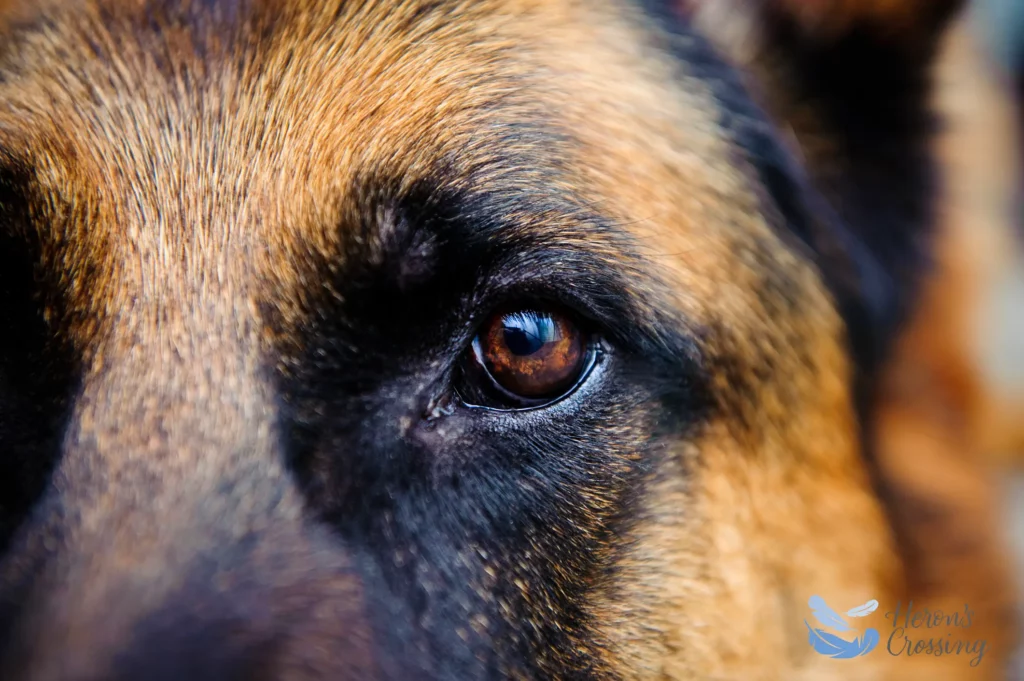Do dogs really see in black and white?
Not exactly. They see colors, but not in the same way we do. And not all colors. Everything has a grayish look, so it’s like one of those black and white photos that has been tinted. And there is a special problem with reds and greens. Those don’t translate to color at all, just gray and tan.
Both humans and dogs have vision photoreceptors called cones concentrated around the center of the eye’s retina, that convert wavelengths of light into colors. Dogs only have one-tenth as many cones as humans, so colors are weak or faded-looking. Also, they can’t perceive the higher wavelengths of red and green as color at all.
But have you ever noticed how, in black and white photos, you can see more details? This is the perfect visual requirement for your dog. Looking for details is his specialty.
Photoreceptors in the eye that perceive black and white are called rods. They are concentrated mostly around the eye’s perimeter, and are used for peripheral and night vision. This is what your dog needs more than the ability to choose his favorite color ball. It helps him to hunt, especially at night, and in conditions like the woods, where it is practically monochromatic anyway, but he needs to see details – like that snake blending into the fallen leaves.
Wild dogs are crepuscular, which means ‘twilight’. They are designed primarily to hunt at dawn and dusk for their meals. To help them out, they have something humans don’t have: a reflective layer of cells in the back of their eyes called a tapetum lucidum that acts as a mirror to amplify dim light. That’s the ‘glowing eyes’ effect you see if you take a flash photo of your dog without angling the camera.
Yet another difference that helps him to see better for a dog is a higher flicker fusion frequency, or FFF. As strange as it sounds, that’s a real thing. It’s a measure of how fast the brain translates a picture the eye receives. You know how moving pictures are single frames, but if they move at 24 frames per second, they appear as continuous motion? Your dog and other fast-moving animals perceive frames of light faster. This helps your dog to see more clearly as he’s running. But the TV screen may appear to be flickering to him, because it is slower.
Also, a dog’s eyes are set farther apart on the face than a human’s eyes, to make his peripheral field of vision even wider. But what suffers as a result of this is his depth perception. He’s not seeing stereoscopically so much, so he’s not going to be able to focus sharply as far away as you can. Your dog’s visual acuity (sharpness) is somewhere around 4 to 8 times worse than yours. So, to compensate, he depends on his sense of smell.
Why does a dog have a third eyelid? Several animals have this. It’s a thin layer of tissue under the lids, in the inner corner of the eye, that can sweep over the eye to keep it moist. However, if you can see it, this could be an indicator that your dog is not well or in pain – a call to the vet would be a good idea.
If you’d like to see the way dogs see, the American Kennel Club recommends Dog Vision. Just mouse over a photo on the website to get a quick look at the difference between what we see and what a dog would see. You can also load your favorite photos to view the difference.
When it comes to shopping for your dog, choose items that are blue or yellow to make playtime more exciting. If the color selection is limited, choose turquoise or purple. He will interpret these as blue, too.
Can dogs see a wider spectrum of light that we can’t see? Researchers say that they can see in the ultraviolet range. This would help them to see where other animals have sprayed to mark territory.
As your dog ages, genetics or diabetes can cause the eye lens to cloud over, obstructing light to the retina. If your dog’s eyes become cloudy, have a veterinarian examine him. Eye surgery is possible, but by the time most dogs show signs, there are too many other aging complications to make it a good choice. Be mindful that he will need more guidance as you lead him around, and more lighting as his sight becomes dim. He’s been a good companion to you. Now it is time to be a good companion to him.
Heron’s Crossing provides end-of-life care for pets in the Metro Atlanta area. In-home appointments with compassionate vets are available. If you’d prefer a home-like setting away from your home, our Decatur office is also available by appointment.

